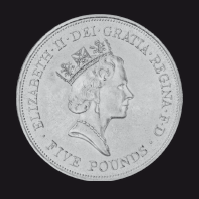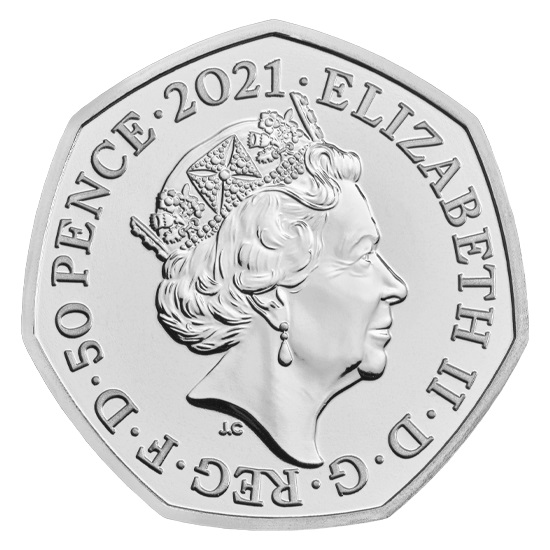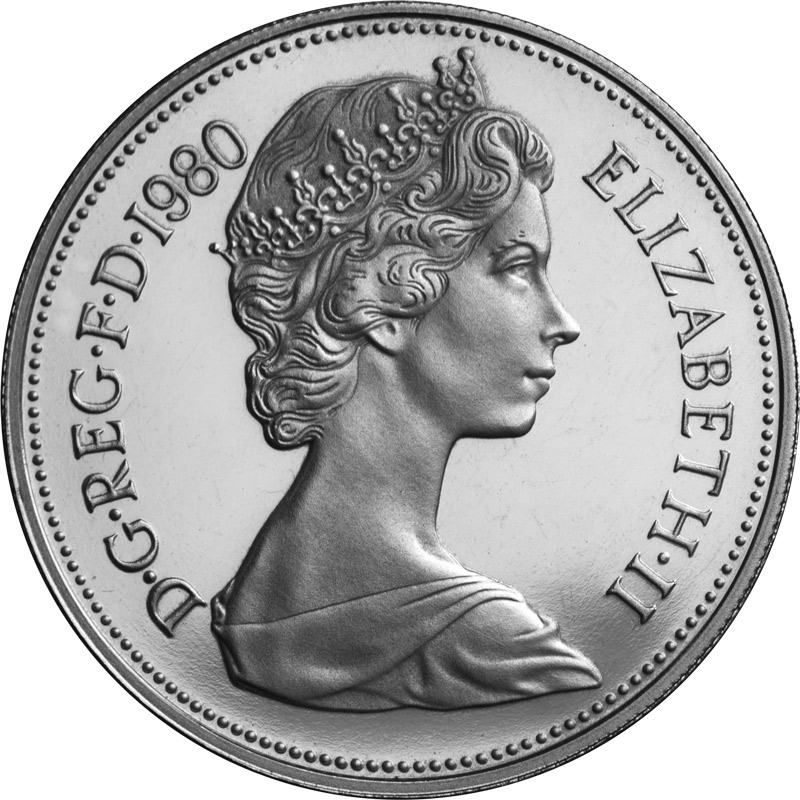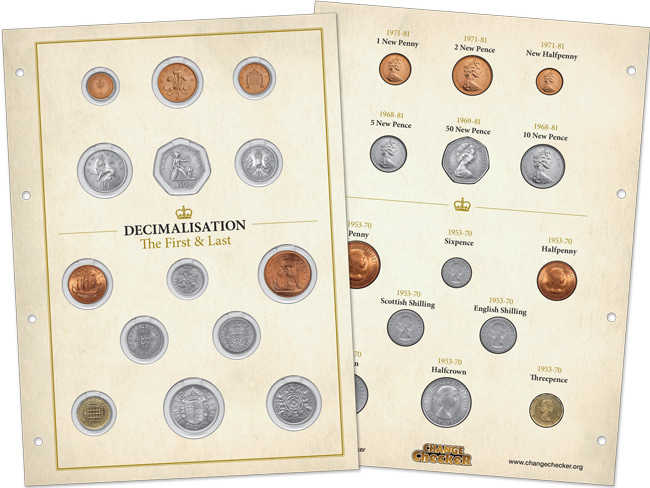Posts Tagged ‘Arnold Machin’
Portraits of our Queen – the changing face of Britain’s coinage
This year marks Her Majesty’s 95th birthday year. Queen Elizabeth II is Britain’s longest reigning monarch, with an incredible 68 years on the throne.
The first Queen Elizabeth II coins were struck in 1953 and since then five different effigies have adorned our coins.
We asked you to vote for your favourite and portrait of Queen Elizabeth II and the results are in…

1953 – 1967: Mary Gillick

The first coins of Queen Elizabeth’s reign bore Mary Gillick’s portrait of the young Queen, engraved especially for the new coins.
Her uncrowned portrait of the Queen is still used on the Maundy Money distributed each year by Her Majesty.
1968 – 1984: Arnold Machin RA

With the upcoming decimalisation, it was decided to refresh the Queen’s portrait with Arnold Machin’s new sculpture of the Queen. Commissioned in 1964, it first appeared in 1968 on the new 5p and 10p coins. A version of the design with tiara was also introduced on stamps in 1967 and remains to this day.
1985 – 1997: Raphael Maklouf

In creating his new effigy of Her Majesty, Raphael Maklouf aimed “to create a symbol, regal and ageless”.
His “couped” portrait depicts Queen Elizabeth II wearing the royal diadem favoured by her on the way to and from the State Opening of Parliament.
1998 – 2015: Ian Rank-Broadley FRBS

In 1997, a new portrait of Her Majesty was designed by Ian Rank-Broadley. Created to fill the full circle of the coin, its larger size was a deliberate response to the smaller 5p and 10p coins in circulation.
A noticeably more mature portrayal of Her Majesty, Rank-Broadley aimed to show the Queen with “poise and bearing”.
2015 – Present: Jody Clark

The new “heads” side of the coin was designed by Jody Clark who at 33 was the youngest person to design a monarch’s profile on the currency.
It was the first time her portrait had been modified in 17 years and has remained on our UK coinage ever since.
This was arguably the first UK coin to introduce elements of personality with a hint of a smile. Clark is the first Royal Mint employee in over 100 years to design a UK definitive coin portrait
As Queen Elizabeth II is now one of the top five longest-reigning monarchs in the world, it’s only fitting that five of her portraits appear on our UK coinage.
Your favourite portrait will be revealed next week, so stay tune to find out if your vote won!
Receive new UK coins without the hassle of placing orders on the day of release!
Join the Change Checker UK CERTIFIED BU Subscription Service and receive new UK coins sent to your door without the hassle of placing orders on the day of release!
Don’t miss your chance to get ahead of the crowd and be one of the very first collectors to receive the latest UK new issue coins as soon as possible after their release.
Happy Birthday Ma’am!
Not only is our Queen now the longest reigning monarch in British history, but today Her Majesty is celebrating her 92nd Birthday – the only British sovereign to reach this milestone.
 To celebrate, we’ve put together a timeline of the most significant moments in history while looking through some of the coins that have adorned Her Majesty’s portraits through the years.
To celebrate, we’ve put together a timeline of the most significant moments in history while looking through some of the coins that have adorned Her Majesty’s portraits through the years.
Elizabeth immediately became Queen after her father King George VI passed away. Her Coronation was delayed for 16 months because of a traditional period of mourning that follows the death of a Monarch. The first commemorative crown of her reign was designed by Gilbert Ledward and captured the hearts of the nation.
The first coins of Queen Elizabeth II’s reign featured the first portrait of Her Majesty by Mary Gillick. The portrait is remembered for reflecting the optimistic mood of the nation and was also used on coinage in many of the commonwealth countries.
In 1965, a crown was released by the Royal Mint which changed everything. This particular Crown is famous for being the first British coin to feature anyone outside the Royal Family – Sir Winston Churchill.
On Decimal Day, the UK and Ireland decimalised their currencies. The new currency system meant that the pound would be divided into units of ten, including half, one, two, five and 50 pence.
The marriage of Queen Elizabeth II and Prince Phillip Mountbatten took place on the 20th November 1947 and in 1972, the couple celebrated 25 years together. The Royal Mint issued the first British coin to have a face value of 25p to mark their 25th Wedding Anniversary.
The thirteenth Commonwealth Games were held in Edinburgh in 1986 which saw the striking of the very first commemorative £2 coin. Not only that, it was the first coin to commemorate a sport.
The very first bi-metallic coin was issued in 1997 – one year prior to the portrait change. This coin is the one and only year that Raphael Maklouf’s portrait appears on the bi-metallic £2 coin. His portrait features Queen Elizabeth II wearing a necklace, which earned the coin its unique status and nickname in the collecting world, the ‘Queen with a Necklace’ £2.
2011 saw the introduction of a new design for the 1oz Silver Britannia who has a long standing history with British coinage. The coin features the 4th portrait by Ian Rank-Broadley which is regarded as being a realistic and mature representation of the Queen.
In 2015, British History was made as Her Majesty Queen Elizabeth II celebrated an incredible Royal milestone, becoming our longest reigning monarch. This remarkable £20 coin was issued in celebration and features all 5 portraits of Her Majesty. The obverse features the fifth portrait of Her Majesty as 2015 was the first year that the Jody Clark portrait was used on UK coinage.
To celebrate the 90th Birthday of Her Majesty Queen Elizabeth II a selection of brand new commemorative coins were issued. Designed by Christopher Hobbs, the coin depicts nine roses – one for each decade of her life as well as the number ’90’ in the centre.
2016 proved to be a significant year for collectors and the 90th Birthday celebrations were no exception. The coins that appeared throughout Her Majesty’s reign have proved to be very popular over the years and we’re sure the 90th Birthday commemorative coins will be favourites among collectors in years to come.
Own your own piece of numismatic history
Add the 2016 UK 90th Birthday CERTIFIED BU £5 to your collection today >>
Almost half of Change Checkers prefer Machin
Jody Clark’s new effigy of Her Majesty means there have now been a total of five Queen Elizabeth II portraits on our decimal coins, and recently we asked you to pick your favourite of the lot.
Voting is now closed, the results are in, and there is a clear winner…
With a landslide of nearly 43% Arnold Machin’s portrayal of Queen Elizabeth II was voted as your favourite.
Machin’s portrait was used on British coins between 1968 and 1984 and replaced Mary Gillick’s coronation portrait which had been in place since 1953.
With decimalisation edging closer in the sixties, it was decided to refresh the existing Queen’s portrait in time for the new coinage.
Gillick’s original was a popular and youthful portrayal, but with the Queen approaching 40, a change was needed.
Arnold Machin was one of several artists chosen to compete for the new effigy. He was a talented sculptor and tutor at the Royal College of Art when his design was chosen for the second portrait and was granted four sittings at Balmoral and Buckingham Palace to perfect his work. It was approved in 1964 but not seen on our coinage until the very first 5p and 10p pieces of 1968.
Like Gillick, Machin decided against the couped (cut-off at the neck) style which had been so common for previous monarchs. He added draping around the shoulders and replaced the laureate with the Girls of Great Britain and Ireland tiara which was given to Elizabeth from Queen Mary as a wedding gift.
A new era for British coins
So why did Machin’s new portrait become so popular, and why is it still popular with Change Checkers?
For many, it is about what his effigy represents. Machin’s elegant portrayal of a young Queen become synonymous with decimalisation and the beginning of a new era for British coins. Of course, for others it is simply about an affinity with the coins they grew up with.
These days, Machin’s portrait only exists on a few denominations, but even if you haven’t noticed it on our coins, it is probably very familiar to you.
In fact, it is the most widely reproduced single work of art in history.
Machin’s effigy was first used on postage stamps in 1967, and has subsequently been used on almost all British definitive stamps. It is estimated that there have been approximately 320 billion copies produced to date, and this figure is rising daily.
Whilst many of us may not be familiar with Arnold Machin, his portrait has reached more people than he could ever have imagined, and it is evidently still a firm favourite with collectors.
Now you have the chance to own some of the very first decimal coins to feature Machin’s new portrait.
The First and Last Decimalisation Collector Page includes 14 original coins which allow you to compare decimal and pre-decimal coins in a rare pairing of old and new.




